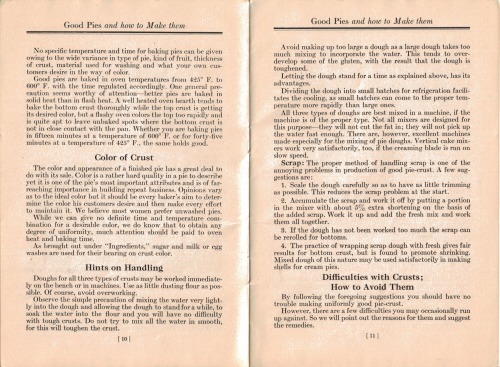 Here is part of page 10 and 11 of the vintage recipe booklet “Good Pies & How To Make Them” that was published in 1928 by Crisco.
Here is part of page 10 and 11 of the vintage recipe booklet “Good Pies & How To Make Them” that was published in 1928 by Crisco.
To review all pages in this booklet, simply visit the Crisco: Good Pies & How To Make Them Category and click on a page title to review that section.
There are scans available of each page, just click the images to view a full size copy.
Hints on Handling
Doughs for all three types of crusts may be worked immediately on the bench or in machines. Use as little dusting flour as possible. Of course, avoid overworking.
Observe the simple precaution of mixing the water very lightly into the dough and allowing the dough to stand for a while, to soak the water into the flour and you will have no difficulty with tough crusts. Do not try to mix all the water in smooth, for this will toughen the crust.
Avoid making up too large a dough as a large dough takes too much mixing to incorporate the water. This tends to over-develop some of the gluten, with the result that the dough is toughened.
Letting the dough stand for a time as explained above, has its advantages.
Dividing the dough into small batches for refrigeration facilitates the cooling, as small batches can come to the proper temperature more rapidly than large ones.
All three types of doughs are best mixed in a machine, if the machine is of the proper type. Not all mixers are designed for this purpose–they will not cut the fat in; they will not pick up the water fast enough. There are, however, excellent machines made especially for the mixing of pie doughs. Vertical cake mixers work very satisfactorily, too, if the creaming blade is run on slow speed.
Scrap: The proper method of handling scrap is one of the annoying problems in production of good pie-crust. A few suggestions are:
- Scale the dough carefully so as to have as little trimming as possible. This reduces the scrap problem at the start.
- Accumulate the scrap and work it off by putting a portion in the mixer with about 5% extra shortening on the basis of the added scrap. Work it up and add the fresh mix and work them all together.
- If the dough has not been worked too much the scrap can be rerolled for bottoms.
- The practice of wrapping scrap dough with fresh gives fair results for bottom crust, but is found to promote shrinking. Mixed dough of this nature may be used satisfactorily in making shells for cream pies.
 More Recipes For You To Enjoy:
More Recipes For You To Enjoy:




